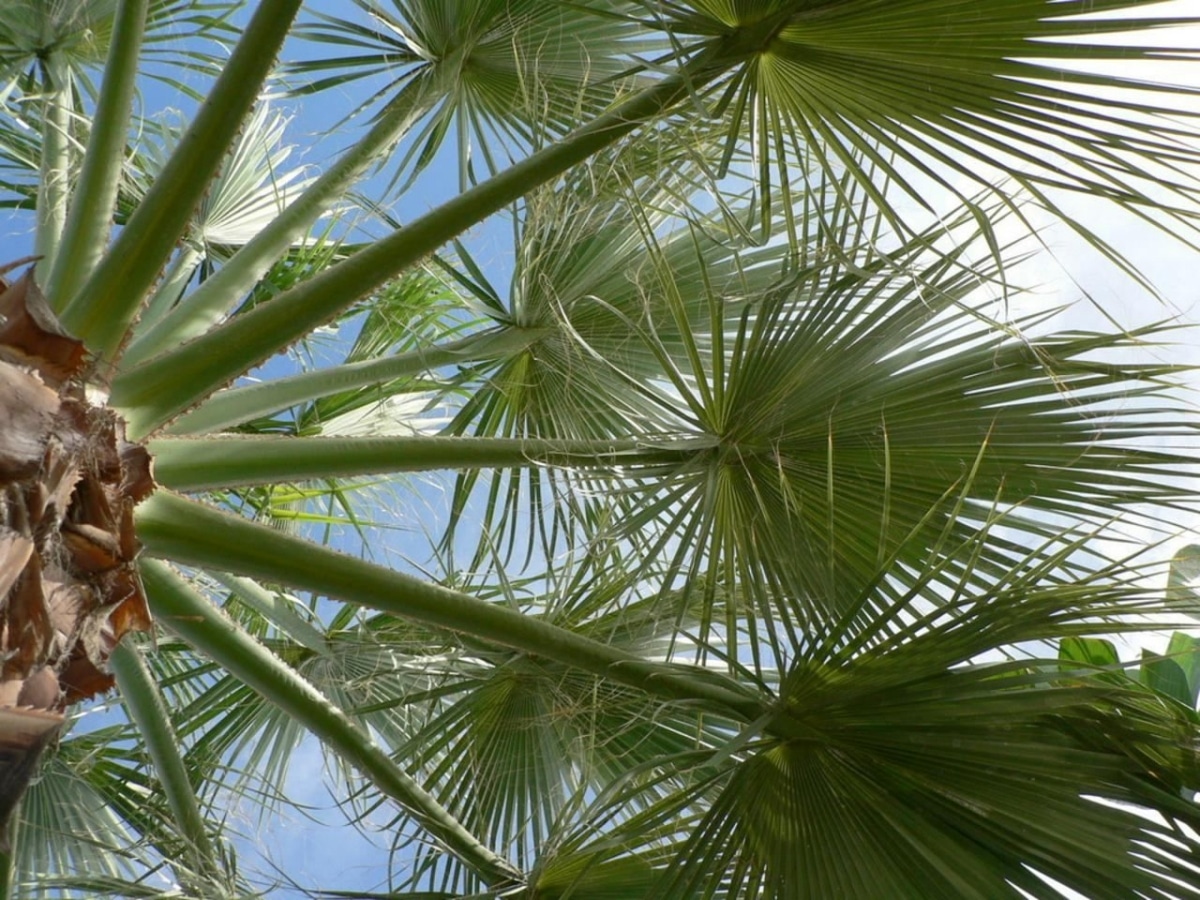
Quoting one of the poems of the writer Pedro Antonio de Alarcón (1833-1891), »I want sun! dying said one day a palm tree, that in a shady orchard, shrouded in its stiff branches, which soul without love languished».
This, which is still literature, is actually based on the reality of many palm trees. And it is that there are many that need the king star to grow properly, but there are others that do not. Therefore, we have to know if the palm trees are sunny or shaded.
Do palm trees need sun or shade?

In nature, palm tree seeds can germinate exposed to the sun if they do not have other plants nearby or if they have been transported by wind, water or animals away from their parents; or they can do it in the shade. This does not mean that just because they started their life in the sun or in the shade, they are plants that need to live in those light conditions throughout their lives. In fact, there are many, such as the Archontophoenix or the Howea (such as the kentia), which grow in the shade but as they gain height, they gradually adapt to direct sunlight.
I would even go so far as to say that, except for a few, the vast majority appreciate being in the shade during their youth. Eye: shadow, but not darkness. These types of plants need lots and lots of light from the start of their lives. This is why they tend to have so many problems when they are kept indoors, because they do not receive enough natural light.
So, to make it easier for you to know which are the palm trees for the sun, which are for the shade and which are the ones that need shade when they are young but sun when they are adults, here is a selection based on my experience (in case you are curious: I have been a collector since 2006, so I have had, and have, a wide variety of plants, palm trees being one of my favorites):
sun palm trees
- Image – Wikimedia/Vengolis // Bismarckia nobilis
- Image – Wikimedia/ANE // Chamaerops humilis in Sierra Cabo de Gata (Almeria)
- Image – Wikimedia/Krzysztof Ziarnek, Kenraiz // butia yatay
- Bismarckia nobilis: this huge and majestic palm tree with fan-shaped leaves of a bluish color (although there is a variety with green leaves, this one is more sensitive to cold), needs to be in the sun from its youth. See file.
- Chamaerops humilis: the Mediterranean heart of palm. It has fan-shaped leaves, green, bluish depending on the variety. It resists drought like few others, and it is not afraid of frosts as long as they are not very intense (although it supports up to -7ºC).
- All of the genus Butia: butia capitata, butia yatay, Butia archeri,… They grow slowly, but are somewhat drought tolerant and tolerate both cold and frost. See file.
- Image – Wikimedia/Donkey shot // Phoenix canariensis
- Image – Flickr/Scott Zone // Jubaea chilensis
- Image – Wikimedia/Emőke Dénes // Washingtonia
- Virtually all of the genus Phoenix: Phoenix canariensis (Canary palm tree), Phoenix dactylifera (date palm), phoenix roebellinii (dwarf palm), phoenix sylvestris (wild palm tree, very thorny), phoenix andamensis (similar to the canary, but much smaller), etc. just the rupicola phoenix It appreciates the shade if the degree of insolation is very high, as it happens in the Mediterranean for example.
- Jubaea chilensis: the Jubaea palm tree. Slow growing, pinnate leaves and thick trunk. Slow growing, but it is a jewel that deserves to have its place in a garden. It resists frost (up to -10ºC) without problems.
- washingtonia: both the Robust Washingtonia and Washingtonia will spinas well as the hybrid Washingtonia x filibusterThey need sun from the beginning of their life.
Shadow palms
- Image – Wikimedia/Eric in SF // Calamus gibbsianus
- Image – Flickr/Mauricio Mercadante // Chamaedorea seifrizii
- Image – Wikimedia/Moebiusuibeom-en // Cyrtostachys renda
- all the squids: Within this genus we find many of the so-called rattan palms. They are usually climbers, growing under the shade of the rainforest canopy.
- All the Chamaedorea: as the Chamaedorea elegans (living room palm tree), Chamaedorea metallica: Chamaedorea seifrizi. These are ideal plants to grow in small gardens, patios or even indoors, as they do not usually exceed 2 meters in height.
- All Cyrtostachys: as the Cyrtostachys renda (red palm). These tropical palm trees, which can have one or more trunks depending on the variety, need shade and very high ambient humidity, as well as mild temperatures throughout the year.
- Image – Wikimedia/Mokkie // Dypsis lutescens
- Image – Flickr/tanetahi // Howea belmoreana
- Image – Wikimedia/David J. Stang // Raphis excelsa
- Genus Dypsis: as the Dypsis lutescens (areca) or the Dypsis decaryi. Originally, they grow in the shade and gradually expose themselves to the sun. But I recommend keeping them in the shade always to prevent them from burning.
- howea: as the Howea forsteriana (kentia), or the Howea belmoreana. Although I have said before that in nature they usually grow in the shade and end up exposed to the sun, in a country like Spain it is preferable to always keep them in the shade, since it is very difficult for them to adapt to direct sun exposure.
- raphis excelsa: the rapis is a multi-stemmed palm with very thin trunks and fan-shaped leaves that is widely used indoors for decoration.
Palm trees that grow in shade and end up exposed to the sun
- Image – Wikimedia/Alejandro Bayer Tamayo from Armenia, Colombia // Archontophoenix alexandrae
- Dictyosperma album
- Image – Wikimedia/Forest & Kim Starr // Caryota mitis
- Archontophoenix: as the Archontophoenix maxima, Archontophoenix Alexandrae., Archontophoenix purpurea, etc. All of this genus start out in shade, but end up exposing themselves to the sun.
- Dictyosperma album: this is the only species in the genus Dictyosperma. It has a thin trunk and pinnate leaves. It is usually known by the name of hurricane palm tree, as it resists strong winds very well. However, it is very sensitive to cold.
- Genus Caryota: as the A burning caryota o mild caryota. Palm trees that grow at a slow rate, and have pinnate leaves that resemble the tail of a fish.
- Image – Wikimedia/Forest & Kim Starr // Veitchia merrillii
- Image – Wikimedia/David Eickhoff // Pritchardia minor
- Image – Wikimedia/Cookie // Sabal maritima
- Genus Veitchia: as the Veitchia merrillii or the veitchia arecina. They are tropical palms, which have a very thin trunk and a crown with few pinnate leaves.
- Virtually all Pritchardia: as the Prichardia pacifica or the Prichardia minor. They bear a certain resemblance to the Washingtonia, but their trunk is more slender, and their leaves are even more elegant.
- All Sabals: As the Sabal uresan, Sabal maritime o Mexican Sabal. These are palm trees that grow very slowly, but they are very beautiful. They have large fan-shaped leaves, and colors ranging from green to bluish-green. See file.
As you can see, not all palm trees are sunny or shaded. I hope this information can help you when choosing a species for your garden.

















